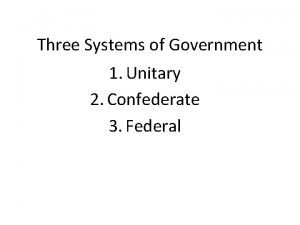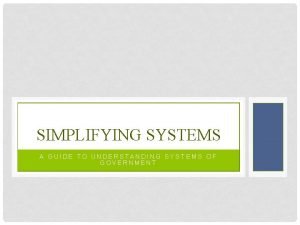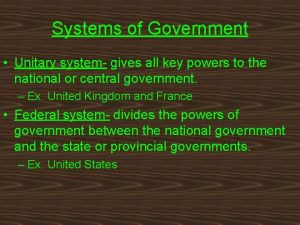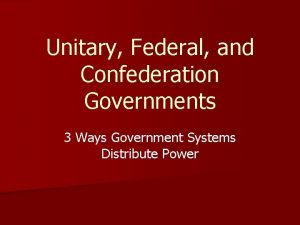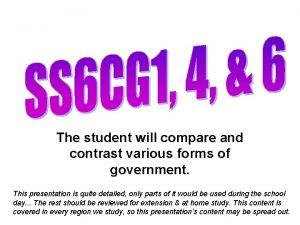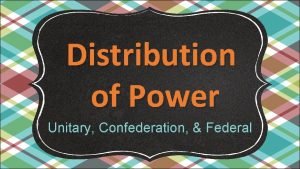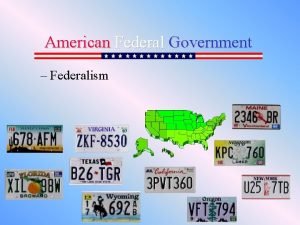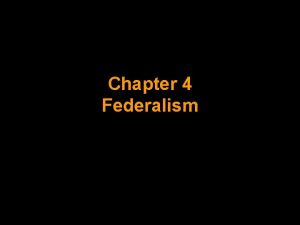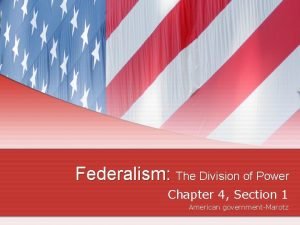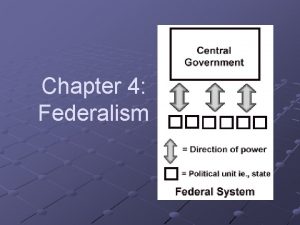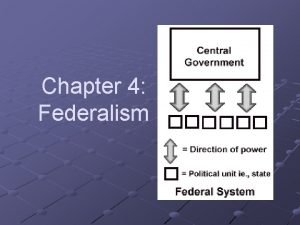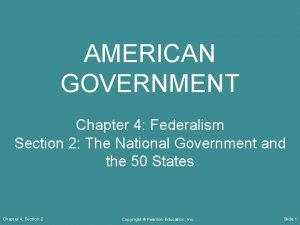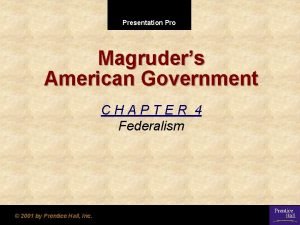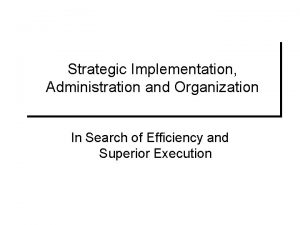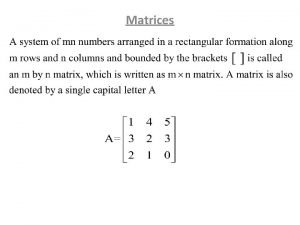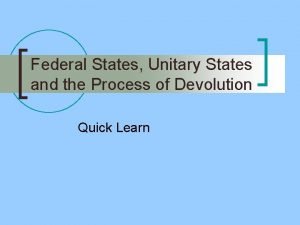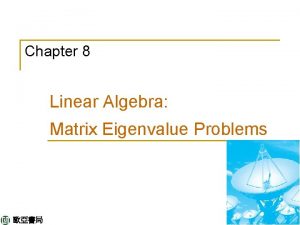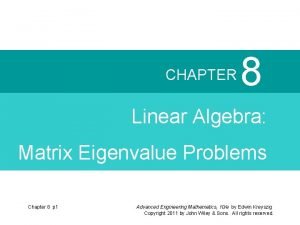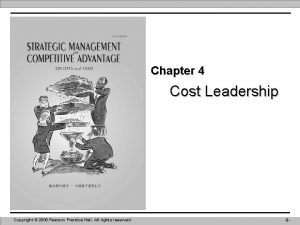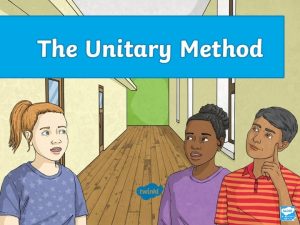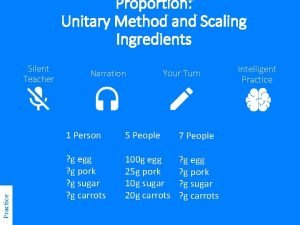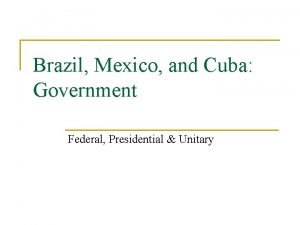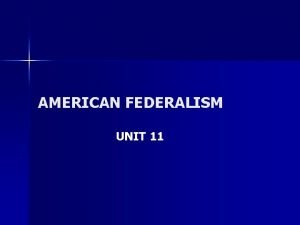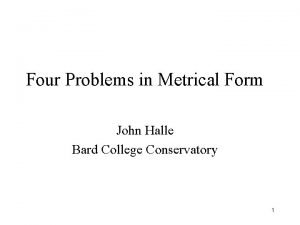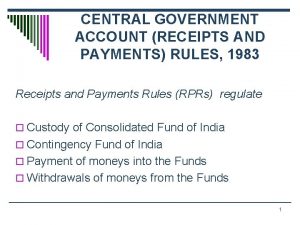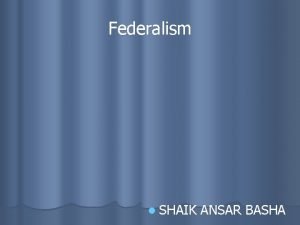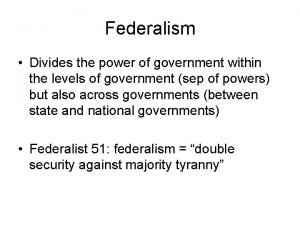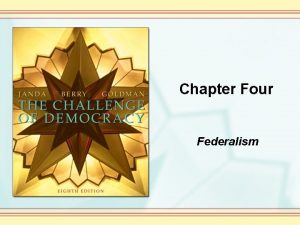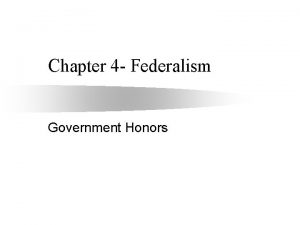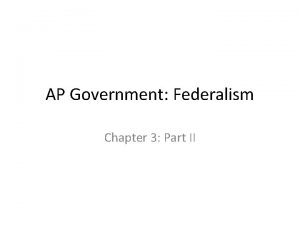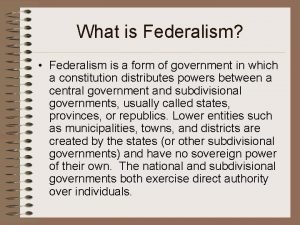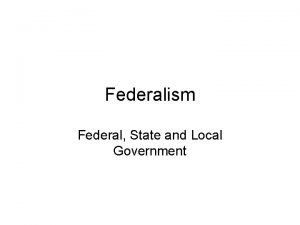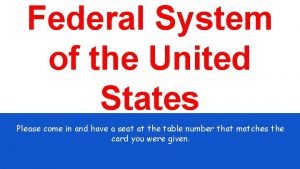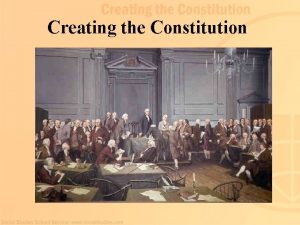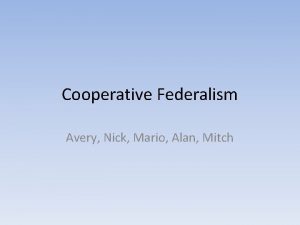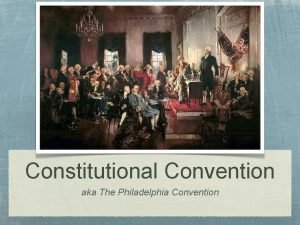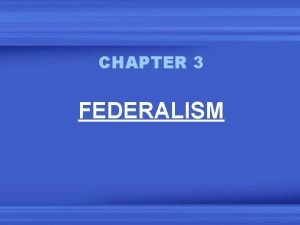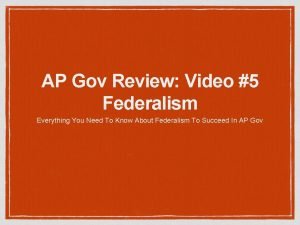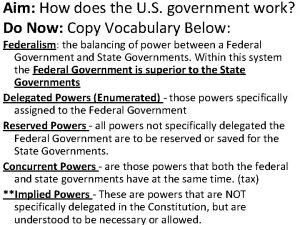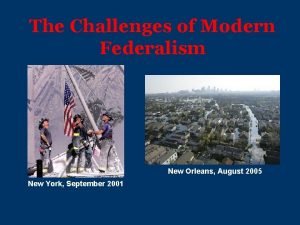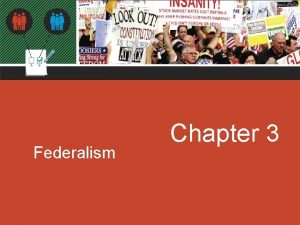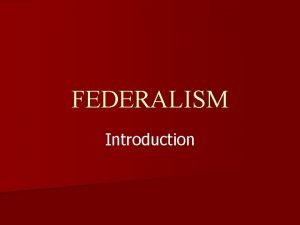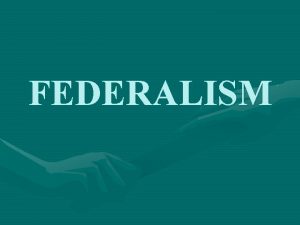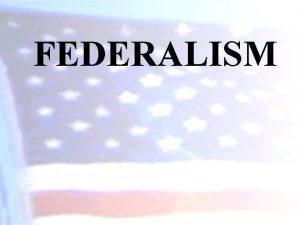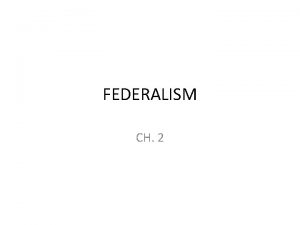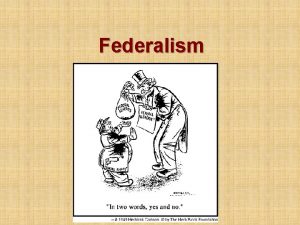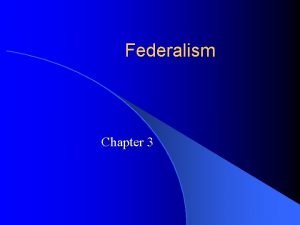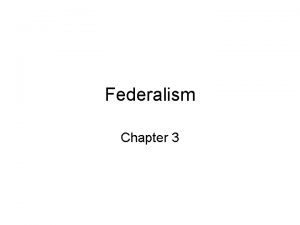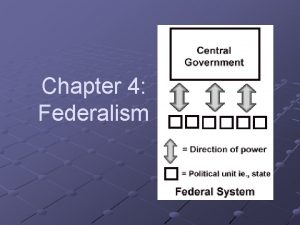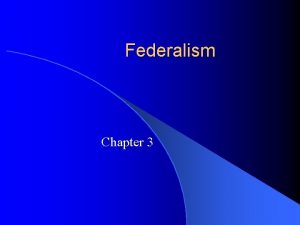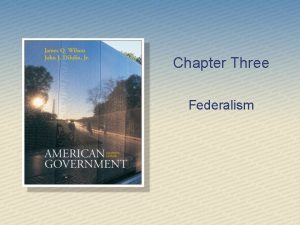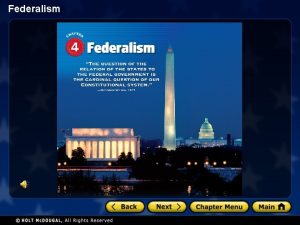Chapter 3 Federalism A Unitary System Central government































































- Slides: 63

Chapter 3: Federalism

A Unitary System « Central government gives power to sub-national governments (counties, provinces, etc. ). « Local governments typically have only those powers granted to them by the central government, rather than any reserved powers. « Especially important is the central government’s role as provider of funds. « England the American Colonies prior to the Revolution are examples of a unitary system. « Top Down Flow Copyright © 2009 Cengage Learning 2

A Confederal System « Power is retained by local or regional governments. « Example: The European Union « Upward Flow Copyright © 2009 Cengage Learning 3

A Federal System « Divides power between the national and lower level governments. « Each government has distinct powers that the other governments cannot override. « Examples: Australia, Brazil, Canada, Germany, India, Mexico, and the United States. « Two Way Flow Copyright © 2009 Cengage Learning 4

Why Federalism? « The authors of the Constitution wanted to combine a central government strong enough to maintain order with strong states. « The large geographical size of a country. « State governments have served as training grounds for national politicians and as laboratories in which new ideas can be tested. « Federalism allows for many political subcultures. Copyright © 2009 Cengage Learning 5

Arguments Against Federalism « A way for powerful states to block plans « Inequalities across states « Some see expansion of national powers as a danger « Smaller political units more likely to be dominated by a single group or interest ©The Granger Collection, New York Copyright © 2009 Cengage Learning 6

The Federal System Scholars and political leaders alike have debated the relative merits and drawbacks of federalism since the founding of the republic. The following slide lists some of the major arguments that have been made. Copyright © 2009 Cengage Learning 7

The Federal System (cont. ) Copyright © 2009 Cengage Learning 8

The Flow of Power in Three Systems of Government Copyright © 2009 Cengage Learning 9

Powers of the National Government « Enumerated Powers: Article 1 Section 8 (TEXT Pages 72 – 73) • The Necessary and Proper Clause specifically allows federal government to make all laws necessary and proper to perform the enumerated powers « Implied Powers « Inherent Powers Copyright © 2009 Cengage Learning 10

Powers of the National Government « Implied Powers - allow the national government to make decisions that fall outside the expressed powers. (Elastic Clause) « Inherent Powers - recognized as belonging to all sovereign nations. (Right to insure survival, right to acquire territory) Copyright © 2009 Cengage Learning 11

Powers of State Governments « According to the Tenth Amendment, all powers that were not delegated to the national government. « In theory states still retain all powers not delegated to the national government, but in reality the national government has expanded the scope of governmental action on a grand scale. Copyright © 2009 Cengage Learning 12

Powers of State Governments « Police power: In the United States, most police power is reserved to the states. « Health, safety, welfare, morality Copyright © 2009 Cengage Learning 13

Concurrent Powers Power to Tax Copyright © 2009 Cengage Learning National Government State Government Power To Make and Enforce Laws Power To Establish Courts Power To Police (Limited) 14

Prohibited Powers « Apply to both the national and state governments • The national government is prohibited from taxing exports. • State governments are prohibited from conducting foreign policy and from coining money. Copyright © 2009 Cengage Learning © AP/ Wide World Photos “Congress… has the power to coin money. ” 15

Supremacy Clause « Article VI of the Constitution mandates that actions by the national government are supreme. « Any conflict between a legitimate action of the national government and a state will be resolved in favor of the national government. Copyright © 2009 Cengage Learning 16

States Suing Federal Government over Health Care « Officials from 14 states have gone to court to block the historic overhaul of the U. S. health care system that President Obama signed into law Tuesday, arguing the law's requirement that individuals buy health insurance violates the Constitution. « Thirteen of those officials filed suit in a federal court in Pensacola, Florida, minutes after Obama signed the Patient Protection and Affordable Care Act. The complaint calls the act an "unprecedented encroachment on the sovereignty of the states" and asks a judge to block its enforcement. Copyright © 2009 Cengage Learning 17

Interstate Relations « Article IV of the Constitution attempts to resolve potential problems between states by stipulating the following: • Full faith and credit clause—states must honor actions of other states • Laws, records, and lawful decisions • A state does not have to enforce another states criminal code • Does not have to recognize divorce if person getting divorce did not establish residence • Privileges and immunities • Interstate extradition Copyright © 2009 Cengage Learning 18

Local Government « Not provided for in the Constitution « Local Governments created by States and subordinate to State government « Local governments take on responsibilities of state as authorized by state constitution « Larger cities generally have home rule, establish tax policy, self govern Copyright © 2009 Cengage Learning 19

Federalism 1789 – 1937 « States generally dominant, particularly in the areas of social and economic regulation « Disputes over national versus state powers have existed from the beginning Copyright © 2009 Cengage Learning 20

Early 1800 s Disputes « Implied powers of the national government (Art 1, Sec 8, Clause 18) « Powers of the national government and states to regulate commerce Copyright © 2009 Cengage Learning 21

Defining Constitutional Powers « Mc. Culloch v. Maryland (1819) « Gibbons v. Ogden (1824) © Bettmann /Corbis Chief Justice John Marshall: “Let the end be legitimate. ” Copyright © 2009 Cengage Learning 22

Mc. Culloch « Doctrine of Implied Powers « Liberal Interpretation of Necessary & Proper Clause • Second National Bank chartered during Madison’s presidency • Many States opposed NB due to competition and concern that NB gave Feds power over States • MD attempted to close NB by taxing, NB Cashier Mc. Culloch refused to pay tax • MD state court ruled that NB must pay tax, Federal Government appealed to Supreme Court • Marshall’s court found that implied powers are broad not narrow – Constitution did not require that everything granted be specifically described, if setting up the bank aided the Government in accomplishing designated powers, the authority to do so could be implied • Also ruled that State could not us taxing power on the national government Copyright © 2009 Cengage Learning under Supremacy Clause 23

Gibbons « Established supremacy of federal government in interstate commerce (Art. 1, Sec 8, Clause 3) • Ogden (New York) and Gibbons (Federal) had competing claims to NY/NJ steam ferryboats • NY Court prohibited Gibbons from NY waters • Broadly defined Commerce to include all business dealings, not just transport of goods • National government could exercise commerce power within states if not solely intrastate commerce • Ruled that Federal Government has exclusive power to regulate interstate commerce (No state power) • Commerce authority not broadly used until 1930 s, Now a primary constitutional basis for regulation by the Federal Government « Copyright © 2009 Cengage Learning 24

States’ Rights « The Jacksonian Era and the shift back to States’ Rights (1829 – 1937) « South Carolina attempted to nullify (render void) a tariff claiming that in a conflict between state and national government state should have ultimate authority over its citizens « Tariffs and Slavery resulted in North/South division and southern states being disenchanted « Dred Scott Decision limited power of federal government to prohibit slavery in the territories Copyright © 2009 Cengage Learning 25

States’ Rights « John Calhoun viewed Constitution as a compact between the states not among the people • Federal Government an agent of the states • States are sovereign • States may nullify/secede from the union Copyright © 2009 Cengage Learning 26

The Civil War Library of Congress Copyright © 2009 Cengage Learning 27

Post Civil War « Power of the Federal Government increased as a result of the Civil War • Post Civil War amendments represented a serious enhancement of national power. The national government now abolished slavery, defined who was an American citizen, and attempted (with limited success) to provide rights to the freed slaves that included the right to vote. • Outcome of Civil War established supremacy of national government and put to rest idea that states could secede • Congress exempted Reconstruction in the South from Judicial Review Copyright © 2009 Cengage Learning 28

Post Civil War « Two stages in development of Federalism since Civil War: Dual Federalism and Cooperative Federalism Copyright © 2009 Cengage Learning 29

Dual Federalism « Emphasized dividing the state and national spheres of power into entirely separate jurisdictions. « Revival of States Rights and return to what existed before the Civil War « Supreme Court reasserted itself as arbiter of what belonged in each sphere Copyright © 2009 Cengage Learning 30

Dual Federalism « Federal Government barred from regulating matters considered to be purely local • National law banning child labor ruled unconstitutional (Hammer v. Dagenhart 1918) • 1922 Child Labor Tax Law ruled unconstitutional • 1923 Federal minimum wage for women ruled unconstitutional • Exercise of police power considered local Copyright © 2009 Cengage Learning 31

Dual Federalism « Supreme Court generally upheld Federal Government actions if associated with Interstate Commerce • Mann Act upheld (Hoke v. US 1913) (New Orleans to Beaumont for prostitution) • Law prohibiting interstate traffic in lottery tickets upheld (Champion v. Ames 1903) Copyright © 2009 Cengage Learning 32

The New Deal and Cooperative Federalism « Ended era of Dual Federalism « State Governments Overwhelmed « Unemployment reached 25% in 1932 « Hoover administration did little Copyright © 2009 Cengage Learning 33

The New Deal and Cooperative Federalism « New Deal legislation vs. Dual Federalism « Cooperative federalism emphasized an expanded role for the national government, and cooperation between the national government and the states. Copyright © 2009 Cengage Learning 34

The New Deal and Cooperative Federalism « FDR advocated strong Federal Role to stimulate the economy « Works Progress Administration, Civilian Conservation Corps, Civil Works Administration, Public Works Administration « Roosevelt’s programs typically were funded by the federal government, but administered by states and local governments, thus creating a cooperative framework for federalist relations. « Marble Cake Federalism – Federal, State, and Local powers intermingled Copyright © 2009 Cengage Learning 35

Share of Nonmilitary Spending by the Federal, State, and Local Governments before and after the Passage of New Deal Legislation Copyright © 2009 Cengage Learning 36

Supreme Court and Cooperative Federalism • National Industrial Recovery Act ruled an unconstitutional regulation of intrastate commerce, Court found that sick NY chickens did not involve interstate commerce • Agricultural Adjustment Act ruled unconstitutional as attempt to regulate a state issue (agriculture) • Bituminous Coal Act, Railroad Retirement Plan, Municipal Bankruptcy Act, Farm Mortgages • Matters of State Authority or not subject to either Federal or State power • FDR attempted to “pack” SC with up to 6 new justices more sympathetic to New Deal Copyright © 2009 Cengage Learning 37

Supreme Court and Cooperative Federalism • SC did a 180 about face in NLRB v. Jones & Laughlin Steel Company (no change in Supreme Court members) • Ruled that Federal Authority extended to all activities impacting Interstate Commerce • Even if the regulated activity itself was wholly within a state (Pittsburgh plant labor relations) • Motels, restaurants, any intrastate business with impacts beyond state line – Congress power to regulate economic affairs under Commerce clause almost unlimited for 50 years Copyright © 2009 Cengage Learning 38

Picket-Fence Federalism « Specific programs and policies involve all levels of government « Horizontal boards are governments « Vertical sections are programs and policies « Federal Government involved in wide array of activities once thought to be strictly State and Local Copyright © 2009 Cengage Learning 39

Implementing Cooperative Federalism « $459 B Est Total Federal Aid to State and Local FY 2007 « Grants used increasingly in the 20 th century to implement programs, $225 Billion estimated FY 2006 « Categorical Grants from Federal to State or Local for specific programs or projects « Often accompanied by numerous restrictions and regulations (strings) « Education, environmental protection, recreation, highways, healthcare Copyright © 2009 Cengage Learning 40

Implementing Cooperative Federalism « Block Grants « Provide federal funds for broad functional areas such as criminal justice, mental-health, community development – more flexible than categorical grants « Federal Mandates Copyright © 2009 Cengage Learning 41

Implementing Cooperative Federalism « Strings - Federal money comes with specific requirements that must be met. Federal Government uses funding to to be involved or even exercise control over matters generally viewed as state issues « Highway funds and Drinking Age, Legal Limit for Intoxication, Speed Limits « No Child Left Behind Funding and federal education standards Copyright © 2009 Cengage Learning 42

Where the Money Goes Copyright © 2009 Cengage Learning 43

Where the Money Goes: Federal Grants to State and Local Governments, by Function, 2007 (in billions of dollars) Copyright © 2009 Cengage Learning 44

MANDATES « Legislation that forces states and municipalities to take a specific action. • • • Environmental Protections Civil Rights Educational Concerns Persons With Disabilities Unfunded Mandates Reform Act 1995 ($50 M) Early 2000 s estimated that mandates cost over $70 M Annually ($29 B States) Copyright © 2009 Cengage Learning 45

PREEMPTION « Federal Government takes over area of regulation previously overseen (or ignored) by State/Local Government • • Based on Supremacy Clause, Article 6 of the Constitution Can be express or implied Legislation regarding use of tobacco Lorillard Tobacco v. Reilly – 1960 s Federal legislation pre -empted any state efforts to restrict tobacco advertising Copyright © 2009 Cengage Learning 46

Accomplishments of National Authority « Economic relief « Civil rights and the War on Poverty « States favor the status quo Copyright © 2009 Cengage Learning 47

Questions « Which level of government do you believe should have taken the lead in terms of addressing this situation—the federal government, the state governments or the local governments? « Is it possible for the different levels of government to coordinate their efforts and fully and effectively cooperate in helping Americans? Copyright © 2009 Cengage Learning 48

Questions (cont. ) « The blame game is difficult and dangerous to play, yet if it is played to whom would you assign the greatest degree of blame for the failure of government to respond to this disaster—the President of the United States, the Governors of Louisiana and Mississippi, or the mayors of the cities that were hit the hardest, especially New Orleans? Copyright © 2009 Cengage Learning 49

Federalism Becomes a Republican Issue « “New Federalism. ” Beginning with President Richard Nixon (1969– 1974), the Republican Party championed devolution, or the transfer of powers from the national government to the states. They called this policy federalism, a new use of the term. Copyright © 2009 Cengage Learning 50

New Federalism « Response to New Deal and Great Society Programs (threat to individual liberty and states) « Associated with the Nixon Administration 1968 into the 1970 s « Called for shifting (devolving) power from Federal Government to States « Block Grants and Revenue Sharing « New Federalism Continued Under Reagan but Revenue Sharing was discontinued (More block grants) « Reagan worked to move programs back to states and also cut federal funding. Copyright © 2009 Cengage Learning 51

Devolution « 1994 Republicans captured Congress, Newt Gingrich, Contract with America « 1995 Unfunded Mandate Reform Act « 1996 Welfare Reform Act – Aid to Families With Dependent Children (Categorical Program) replaced by Temporary Assistance to Needy Families (Block Grants) « Reduced Federal Spending to state/local governments Copyright © 2009 Cengage Learning 52

The Politics of Federalism Republican Party tends to support devolution, the transfer of power from national to state governments. Today it is not clear it is as partisan an issue, as President Clinton signed the Welfare Reform Act in 1996. Copyright © 2009 Cengage Learning 53

Federalism and the Supreme Court « Reigning in the Commerce Power « State Sovereignty and the Eleventh Amendment « Tenth Amendment Issues Copyright © 2009 Cengage Learning 54

Federalism and the Supreme Court « United States v. Lopez 1995 « Gun Free School Zones Act 1990 banned possession of guns within 1000 feet « San Antonio 12 th grader Lopez convicted for carrying concealed. 38 on school grounds « Court found act unconstitutional, “nothing to do with commerce or commercial enterprise” « First time in 60 years that SC placed limit on national power under the commerce clause Copyright © 2009 Cengage Learning 55

Federalism and the Supreme Court « 2000 United States v. Morrison « Supreme Court ruled Congress had overstepped its authority under the Commerce Clause in the Violence Against Women Act of 1994. Stated that even documented evidence of violence against women did not justify national regulation of noneconomic violent criminal conduct. Copyright © 2009 Cengage Learning 56

The Politics of Federalism « States’ rights have been associated with conservatism, and national authority has been associated with liberalism. Why? Copyright © 2009 Cengage Learning 57

The Politics of Federalism • Expansion of National Authority associated with Social Change • Aftermath of Civil War • Government Involvement in Economy after Great Depression • Civil Rights Acts • Desegregation • War on Poverty Copyright © 2009 Cengage Learning 58

The Politics of Federalism • States and the status quo • Freedom from national standards • Competition Among States • Local Economic Interests Copyright © 2009 Cengage Learning 59

Recent Issues • • • Clinton and Welfare Reform Bush and Education Gay Marriage Abortion Health Care Copyright © 2009 Cengage Learning 60

KATRINA « FEMA – Michael Brown « Ray Nagin and Kathleen Blanco « Corps of Engineers « Congress « Local Levee Boards Copyright © 2009 Cengage Learning 61

« Traditionally, all matters involving marriage, divorce, and the custody of children have been handled through state laws. « A few states have passed legislation that allows gay marriage or legally recognized civil unions. « In 1996, Congress passed the Defense of Marriage Act, which allows state governments to ignore samesex marriages performed in other states. Copyright © 2009 Cengage Learning 62

If the Supreme Court ruled the Defense of Marriage Act unconstitutional, it would: Force all states to recognize same-sex marriages. State inheritance laws, insurance laws, and adoption laws would need to be changed to accommodate same sex couples. Copyright © 2009 Cengage Learning 63
 What is a unitary system of government
What is a unitary system of government What is a unitary system of government
What is a unitary system of government What is a unitary system of government
What is a unitary system of government A unitary system of government gives all key powers to the
A unitary system of government gives all key powers to the Federal system
Federal system Unitary form
Unitary form How is power distributed in a unitary government
How is power distributed in a unitary government Federalism definition government
Federalism definition government Federalism
Federalism Federalism the division of power chapter 4 section 1
Federalism the division of power chapter 4 section 1 Chapter 4 federalism the division of power
Chapter 4 federalism the division of power Chapter 4 federalism
Chapter 4 federalism Chapter 4 federalism
Chapter 4 federalism Chapter 4 federalism answer key
Chapter 4 federalism answer key Chapter 4 federalism
Chapter 4 federalism Unitary form organizational structure
Unitary form organizational structure Skew hermitian matrix example
Skew hermitian matrix example Unitary demand
Unitary demand Unitary systems
Unitary systems Unitary elastic
Unitary elastic Is japan a unitary state
Is japan a unitary state Orthogonal matrix example
Orthogonal matrix example Eigenvalue of matrix 2x2
Eigenvalue of matrix 2x2 Unitary form organizational structure
Unitary form organizational structure Unitary form organizational structure
Unitary form organizational structure The cost
The cost Martha rogers pattern
Martha rogers pattern 2d orthogonal and unitary transforms
2d orthogonal and unitary transforms Unitary elastic demand
Unitary elastic demand Offensive realism
Offensive realism Is silent night unitary
Is silent night unitary Cuba
Cuba Unitary definition
Unitary definition Unitary definition
Unitary definition Unitary transformation
Unitary transformation Halle hayes xxx
Halle hayes xxx Unitary fermi gas
Unitary fermi gas State and federal constitutions
State and federal constitutions Receipt and payment rules 1983
Receipt and payment rules 1983 Features of federalism
Features of federalism Section quiz 4-3 developing federalism
Section quiz 4-3 developing federalism Federalists and anti-federalists
Federalists and anti-federalists Difference between regionalism and federalism in a sentence
Difference between regionalism and federalism in a sentence How is federalism practised
How is federalism practised Federalists definition
Federalists definition Cooperative federalism
Cooperative federalism The basic premise of federalism is that
The basic premise of federalism is that Full faith and credit clause examples
Full faith and credit clause examples Federalism
Federalism Fiscal federalism definition ap gov
Fiscal federalism definition ap gov Advantages of federalism
Advantages of federalism Dual federalism
Dual federalism Pubilus
Pubilus Dual federalism
Dual federalism Dual federalism
Dual federalism Federalist vs anti federalist political cartoon
Federalist vs anti federalist political cartoon Problems with the articles of confederation
Problems with the articles of confederation Cooperative federalism
Cooperative federalism Federalism in the constitution
Federalism in the constitution Dual federalism
Dual federalism Enumerated powers definition ap gov
Enumerated powers definition ap gov How does the us government work
How does the us government work Conflicted federalism definition
Conflicted federalism definition Albuquerque journal
Albuquerque journal
